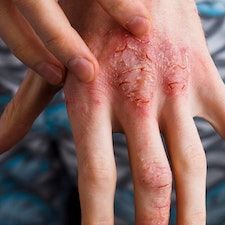Electrical Impedance Spectroscopy Effective in Differentiating Eczema Versus Healthy Skin in Children
This new data resulted from the first study that found EIS could detect skin barrier dysfunction among children found to have developed atopic dermatitis early on in life.

Electrical impedance spectroscopy (EIS) has the capability to detect dysfunction of the skin barrier and to identify the differences in skin of children with atopic dermatitis (AD) versus those without, according to recent findings, suggesting EIS’s potential ability to predict future development of AD.1
This new data resulted from a study which sought to assess the utilization of EIS as a tool to identify skin barrier dysfunction in children, given that it has previously been studied in mice models and among adult patients with AD.2,3
This new research into the use of EIS in children was led by Mari Sasaki, from the University Children's Hospital Zürich in Switzerland. Sasaki and colleagues sought to explore the use in this particular age group as they could benefit most from such a noninvasive and quick examination method.
“Here, we aimed to assess whether EIS can be used to identify skin barrier dysfunction or the changes in skin in children who developed AD in the first 3 years of life using data from the CARE (Childhood AlleRgy, nutrition, and Environment) birth cohort study,” Sasaki and colleagues wrote.
Background and Findings
The investigators utilized data which was drawn from the CARE (Childhood AlleRgy, nutrition, and Environment) birth cohort study, an ongoing prospective birth cohort study done in St. Gallen, Switzerland since 2016. The study sought to assess the link between early life exposures and the development of allergic diseases such as AD.
Newborns were recruited at the Cantonal Hospital of St. Gallen and monitored through physical examinations at 4 months, 1, 2, and 3 years old. They also used questionnaires which were administered to the subjects at several different intervals up to their reaching 3 years of age.
The study’s data was on information on allergic disease symptoms, environmental elements, and demographic information. The investigators’ study doctor was instructed to examine AD presence and its severity through the SCORAD index at the time of their physical examinations, and skin prick tests for specific allergens were done as well.
The disease status of each of the subjects included in the data was decided upon by the research team through a combination of physical checkup findings and questionnaire responses, with the investigators maintaining a focus on diagnosis and on the onset of AD symptoms.
For children with the skin disease, their measurements were categorized by their investigators into active AD measurements, measurements taken prior to AD onset, non-active measurements, and measurements taken following the onset without active symptoms. EIS measurements were obtained by the investigators through the Nevisense EIS device, which determined electrical impedance at several different frequencies.
Each of the measurements included 220 data points, and they are taken on the ventral forearm where subjects’ skin is unaffected. The team’s EIS measurements began in April 2019, and the children who did not show earlier measurements or those who completed measurements up to 2 years old were still kept in the investigators’ analysis if they were shown to have clear AD status.
The investigators differentiated between control measurements with no AD and those with active AD measurements by developing a machine learning algorithm using the EIS measurements and subjects’ AD status as the input. A distinct algorithm—the EIS/AD score—was created to distinguish between measurements taken at 4 months and those at 3 years old, with the overall goal of assessing the impact of subject age on EIS using a parallel approach.
Using the childrens’ EIS/AD scores, the investigators found that the EIS algorithm effectively distinguished between subjects having ‘normal’ skin and having unaffected skin that still had active AD, with an area under the curve of 0.92 (95% CI, 0.85 - 0.99). Additionally, the team found that the algorithm identified disparities between skin deemed as healthy and skin affected by AD in situations where the subject did not have active symptoms of the disease.
Notably, the investigators found no apparent link between the EIS/AD score and the severity of the skin disease or the existence of sensitization to the allergens they had tested in their research. Additionally, they noted that the algorithm's performance was shown to have been consistent across each of the age ranges.
“In conclusion, we were able to show that EIS can detect skin barrier dysfunction in children with AD, including when they did not have active symptoms,” they wrote. “Whether EIS can be used as a predictor of AD development, by itself or in combination with other known genetic or environmental risk factors is an interesting topic of future research.”
References
- Sasaki, M, Sundberg, M, Frei, R, et al. Electrical impedance spectroscopy detects skin barrier dysfunction in childhood atopic dermatitis. Allergy. 2023; 00: 1-11. doi:10.1111/all.15895.
- Rinaldi AO, Morita H, Wawrzyniak P, et al. Direct assessment of skin epithelial barrier by electrical impedance spectroscopy. Allergy. 2019; 74(10): 1934-1944.
- Rinaldi AO, Korsfeldt A, Ward S, et al. Electrical impedance spectroscopy for the characterization of skin barrier in atopic dermatitis. Allergy. 2021; 76(10): 3066-3079.